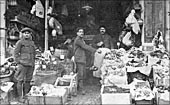|
|
 |
 |
 |
 |
 |
 |
| Structural changes in the field of agriculture
The substitution of the cultivation of raisins for tobacco in the first decades of the 20th century reached its peak after 1922. Farming economy was mainly based on tobacco, the exports of which represented 70% of the total national product and formed the main source of exchange, employing 150,000 families. The crisis in international markets led the to the collapse of the tobacco industry: in the period 1929-33, tobacco exports fell by 1/3 in quantity and by 81% in value. The depression also hit the other traditional agricultural products of the country, that is, olive oil and raisins.
In a sprit of self-sufficiency, adopted in order to face the crisis and aid the expansion of the domestic market, the production of other goods destined for local consumption developed. The production of cereals, for instance, more than doubled between 1928 and 1938, while in the same period the cultivation of cotton, vegetables and other goods multiplied. As a result of the forceful entry of farming into the domestic consumer market, total production increased dramatically in the 1930s. At the same time, the fall in price of some products due to the crisis made the demand for state control and welfare more urgent. Thus a new state intervention policy was inaugurated, to be intensified and crystallized under new guises during the dictatorial Regime.
|
 |
 |
|




